We’ve compiled a list of the four best flashlights for hiking and backpacking in 2023, so your trip will not get ruined by not finding the way in the dark. A dependable and lightweight flashlight is a must-have item for all outdoor adventurers. Here you’ll find information on lightweight, battery life, lumens, water resistance, beam distance, and more. Everything you need to decide what type of flashlight can meet your requirements while providing optimal performance in any environment or terrain.
top 4 Flashlights for Hiking and Backpacking
Here is the list of our top-picked flashlights for hiking and backpacking.
Bonus:
HOW TO PROTECT YOUR TOES WHEN HIKING DOWNHILL THE ULTIMATE GUIDE
Fenix PD36R – (Editor’s Pick Powerful Tactical EDC Flashlight)
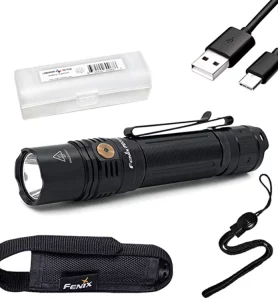
The Fenix PD36R is our top pick for its impressive maximum output of 1600 lumens and a beam throw of up to 928 feet. It also boasts three brightness levels, strobe mode, a rechargeable battery, and an IPX8 rating, making it a waterproof flashlight. It is also one of the best EDC flashlights.
| Pros | Cons |
|---|---|
| ✅ Different levels of light. | ❌ May won’t hold a charge. |
| ✅ Highest settings. | ❌ You may not find batteries and chargers individually. |
| ✅ Super bright. | |
| ✅ Eco mode. |
Klarus XT11GT Pro v2.0 – (Best Heavy Duty Flashlight)
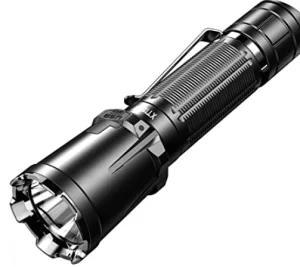
This flashlight has four output modes ranging from 3300 lumens (high) to 10 lumens (low). It also has an adjustable focus that allows you to switch between a wide and focused beam, giving you ample lighting options for any situation. It is made of aircraft-grade aluminum alloy that is both lightweight and durable, making it perfect for your outdoor adventures this coming year.
With the Klarus XT11GT, you can be sure you’ll have reliable lighting no matter where your journey takes you. Its compact power made it one of the best flashlights for hiking and backpacking.
| Pros | Cons |
|---|---|
| ✅ 3100 mAh battery. | ❌ No side switch. |
| ✅ Great duty light. | ❌ Charges at normal speed. |
| ✅ Small and compact. |
Olight S1R II – (Brightest Light Output)
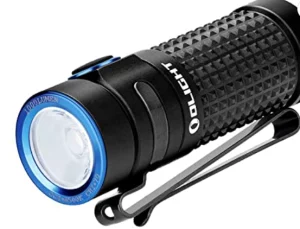
The Olight S1R II is the perfect choice for anyone in need of light that is both powerful and compact. With an impressive 1000 lumens of brightness, this flashlight has been designed to be sturdy and durable while providing exceptional performance in lighting conditions.
Its rechargeable lithium-ion battery can last up to two hours on a single charge, and it has three different brightness settings that can be adjusted to meet your needs. It is known as the best battery flashlight.
| Pros | Cons |
|---|---|
| ✅ Premium beam | ❌ No plastic between battery and connection. |
| ✅ Three-color power level indication. | ❌ Comes without a battery. |
| ✅ Value for money. | |
| ✅ Easy to use. |
Anker Bolder LC90 – (Best Budget Flashlight)
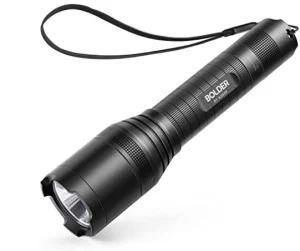
Finally, if you’re on a budget but still want quality performance, we recommend the Anker Bolder LC90. This flashlight offers up to 900 lumens of output, a beam throw of up to 654 feet, five brightness levels, and an IPX5 waterproof rating. It’s also incredibly affordable, making it a great option for those who don’t want to break the bank. But its features made it one of the best rechargeable options for flashlights.
| Pros | Cons |
|---|---|
| ✅ Easy to replace the battery. | ❌ Heavy. |
| ✅ High-quality. | ❌ On/Off mode change may don’t work as specified. |
| ✅ Micro USB charging port. |
Bonus:
Flashlights vs Headlamps
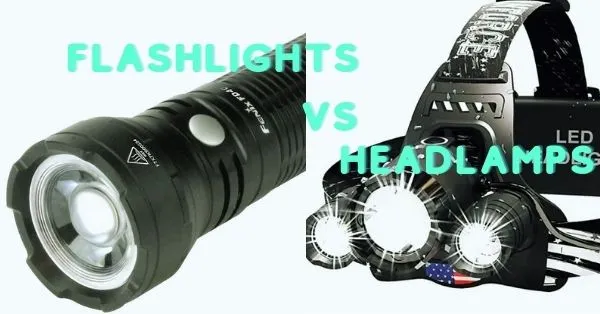
The main difference between flashlights and headlamps is that; both of them are popular portable lighting options with distinct features and benefits. Here’s a comparison of the two:
- Hands-free operation: Headlamps allow you to keep your hands free, especially when performing tasks in low-light conditions. Flashlights require you to hold them in your hand, which can be inconvenient and tiring.
- Directional lighting: Headlamps provide directional lighting, which means you can point the beam of light wherever needed. This is particularly useful when focusing on a specific task or area. Flashlights offer less directional control, and you may need to adjust your grip or position to get the light where you need it.
- Brightness: Headlamps generally offer a lower level of brightness compared to flashlights. Flashlights can be much brighter and can illuminate a larger area. However, headlamps are usually sufficient for most tasks and can be more practical when conserving battery life.
- Battery life: Both flashlights and headlamps can run on disposable or rechargeable batteries. However, headlamps typically have longer battery life due to their lower brightness level. This can be a significant advantage if you’re going on a long camping trip or need to use your light for extended periods.
- Size and weight: Headlamps are generally smaller and lighter than flashlights, making them easier to carry and store. This makes them a popular choice for outdoor activities such as camping and hiking, where space and weight are at a premium.
- Price: Both flashlights and headlamps come in a wide range of prices, from budget options to high-end models. Generally, headlamps are more expensive than flashlights due to their more advanced features and longer battery life. For more ideas visit my Pinterest.
Pros and Cons of Adjustable Light Lens
Light Adjustable Lenses (LALs) are a relatively new technology in the field of ophthalmology that allows for customized vision correction after cataract surgery. Like any medical technology, there are pros and cons associated with using LALs. Here are some of the key advantages and disadvantages of using LALs:
Pros:
- Customizable vision correction: LALs allow personalized vision correction tailored to each patient’s needs. So, this means the lens can be adjusted after surgery to fine-tune the patient’s vision, resulting in better outcomes and higher patient satisfaction.
- Reduced need for glasses: Because LALs can be adjusted after surgery, there is a reduced need for glasses or contact lenses. This can be particularly beneficial for patients who have had difficulty finding glasses or contacts that provide the level of correction they need.
- Improved quality of life: With LALs, patients can achieve clearer vision without needing glasses, improving their quality of life and enhancing their ability to perform everyday tasks.
- Better outcomes: LALs have been shown to provide better visual outcomes compared to traditional intraocular lenses (IOLs). This is because they can be adjusted to correct for any residual refractive errors after surgery, resulting in better visual acuity.
Cons:
- Cost: LALs can be more expensive than traditional IOLs, making them less accessible for some patients. Insurance coverage may also vary, making the procedure more expensive for some individuals.
- Additional time and visits: The process of adjusting LALs can require multiple visits to the ophthalmologist, which can be time-consuming and may require additional travel for some patients.
- Potential complications: As with any medical procedure, there is a risk of complications associated with using LALs. These can include infection, inflammation, and damage to the eye.
- Limited availability: LALs are a relatively new technology and may not be available at all ophthalmology clinics or hospitals. Patients may need to travel to find a provider who offers LALs, which can be a barrier for some individuals.
LALs offer many potential benefits for patients undergoing cataract surgery, including customizable vision correction and reduced need for glasses. However, the cost, additional time and visits required, potential complications, and limited availability may be a barrier for some patients. Patients must discuss their options with their ophthalmologist to determine if LALs are the right choice for their needs and circumstances.
Buying Guide
When looking for the best flashlights for hiking and backpacking, there are several factors to consider.
Size and weight: Look for a flashlight that is lightweight and small enough to easily fit in your backpack or pocket without adding too much bulk.
Brightness and beam distance: The brightness of a flashlight is measured in lumens. So, for hiking and backpacking, a flashlight with 100-300 lumens should provide sufficient brightness for most situations.
Battery life: Look for a flashlight with good battery life, as you’ll need it to last throughout your hike or backpacking trip. Rechargeable batteries can be convenient, but make sure you have a way to charge them on the go if necessary.
Durability and water resistance: Choose a flashlight with robust construction to withstand the wear and tear of hiking and backpacking. Look for a flashlight with at least an IPX4 water resistance rating, which will protect it from splashing water.
Modes and features: A flashlight with multiple modes (such as low, medium, high, and strobe) allows you to adjust the brightness according to your needs.
Ease of Use and Price: Look for a flashlight with a user-friendly interface, such as an easy-to-locate power button, a comfortable grip, and a simple mechanism to switch between modes. Consider your budget when choosing a flashlight.
Conclusion
Once you’ve decided which flashlight is best for your needs, it’s important to know how to use and maintain it. Before each use, always check that the battery is fully charged and that all components are in working order. Keep your flashlight protected from extreme temperatures and moisture when you’re out in the wild.
After each adventure, remember to clean the lens and other parts of the flashlight to remove any dirt or dust that may have built up during use. With proper use and care, your flashlight will last many years of outdoor exploration. With the right flashlight, you can confidently explore even the darkest trails.
Whether camping in the woods or trekking up a mountain, these ten best flashlights for hiking and backpacking will make your outdoor adventures enjoyable and stress-free in 2023! Buy The Best Flashlight Now and Enjoy Your Adventures. Happy Hiking:)!
FAQs
Q 1: How many lumens do you need for a hiking flashlight?
Ans: As a general rule, a hiking flashlight with a minimum of 100 lumens should be sufficient for most hikes, especially if you’re carrying a backup light source or if you’re hiking during daylight hours. However, if you’re planning on hiking in the dark or in low-light conditions, you may need a flashlight with higher lumens, such as 300 to 500 lumens or more.
It’s also important to consider the flashlight’s battery life, as higher lumens often mean shorter battery life. Additionally, the beam type and distance should also be considered. A spotlight beam may be more beneficial for long-distance illumination, while a flood beam may be better for wide-area lighting. Moreover, the lumens needed for a hiking flashlight depend on your specific needs and preferences. Choosing a versatile, durable flashlight with features that suit your particular hiking needs is best.
Q 2: What flashlight do Navy Seals use?
Ans: The exact flashlight used by Navy SEALs is not publicly disclosed due to security reasons. However, it is known that Navy SEALs use high-quality, durable flashlights that are specifically designed for tactical situations. Moreover, these flashlights are typically made from rugged materials like aircraft-grade aluminum and are designed to be waterproof, shockproof, and able to withstand extreme conditions.
Some popular brands of flashlights used by military and law enforcement personnel, including Navy SEALs, include SureFire, Streamlight, and Pelican. Moreover, these brands are known for producing high-quality, durable flashlights with features like multiple brightness levels, strobe modes, and adjustable beams.
Q 3: How many lumens does a self-defense flashlight need?
Ans: Ultimately, the ideal lumens for a self-defense flashlight will depend on your personal preference and the situation in which it will be used. It’s important to choose a high-quality, reliable flashlight with features that suit your specific self-defense needs.
Bonus:

